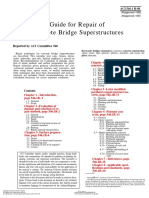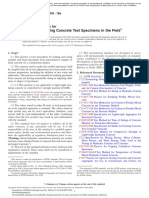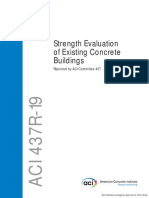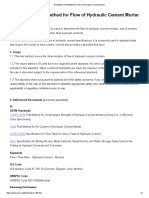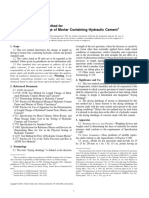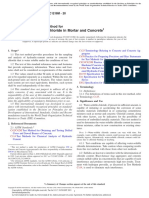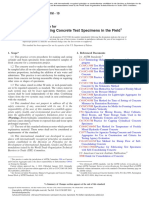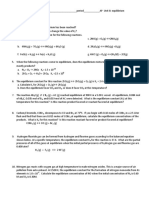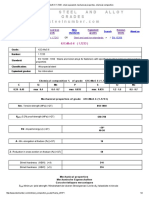Astm C157-14
Astm C157-14
Uploaded by
Fernando ChavarriaCopyright:
Available Formats
Astm C157-14
Astm C157-14
Uploaded by
Fernando ChavarriaOriginal Title
Copyright
Available Formats
Share this document
Did you find this document useful?
Is this content inappropriate?
Copyright:
Available Formats
Astm C157-14
Astm C157-14
Uploaded by
Fernando ChavarriaCopyright:
Available Formats
Designation: C157/C157M 08 (Reapproved 2014)1
Standard Test Method for
Length Change of Hardened Hydraulic-Cement Mortar and
Concrete1
This standard is issued under the fixed designation C157/C157M; the number immediately following the designation indicates the year
of original adoption or, in the case of revision, the year of last revision. A number in parentheses indicates the year of last reapproval.
A superscript epsilon () indicates an editorial change since the last revision or reapproval.
This standard has been approved for use by agencies of the U.S. Department of Defense.
1 NOTEEditorial corrections were made in November 2014.
1. Scope* C192/C192M Practice for Making and Curing Concrete Test
1.1 This test method covers the determination of the length Specimens in the Laboratory
changes that are produced by causes other than externally C305 Practice for Mechanical Mixing of Hydraulic Cement
applied forces and temperature changes in hardened hydraulic- Pastes and Mortars of Plastic Consistency
cement mortar and concrete specimens made in the laboratory C490 Practice for Use of Apparatus for the Determination of
and exposed to controlled conditions of temperature and Length Change of Hardened Cement Paste, Mortar, and
moisture. Concrete
C511 Specification for Mixing Rooms, Moist Cabinets,
1.2 The values stated in either SI units or inch-pound units Moist Rooms, and Water Storage Tanks Used in the
are to be regarded separately as standard. An exception is with Testing of Hydraulic Cements and Concretes
regard to sieve sizes and nominal size of aggregate, in which C596 Test Method for Drying Shrinkage of Mortar Contain-
the SI values are the standard as stated in Specification E11. ing Hydraulic Cement
Within the text, the SI units are shown in brackets. The values C1437 Test Method for Flow of Hydraulic Cement Mortar
stated in each system may not be exact equivalents; therefore, E11 Specification for Woven Wire Test Sieve Cloth and Test
each system shall be used independently of the other. Combin- Sieves
ing values from the two systems may result in non- E337 Test Method for Measuring Humidity with a Psy-
conformance with the standard.
chrometer (the Measurement of Wet- and Dry-Bulb Tem-
1.3 This standard does not purport to address all of the peratures)
safety concerns, if any, associated with its use. It is the
responsibility of the user of this standard to establish appro- 3. Terminology
priate safety and health practices and determine the applica-
bility of regulatory limitations prior to use. 3.1 DefinitionsThe terms used in this test method are
defined in Terminology C125.
2. Referenced Documents 3.2 Definitions of Terms Specific to This Standard:
2.1 ASTM Standards:2 3.2.1 length change, nan increase or decrease in the
C125 Terminology Relating to Concrete and Concrete Ag- length of a test specimen that has been caused to change by any
gregates factor other than externally applied forces and temperature
C143/C143M Test Method for Slump of Hydraulic-Cement changes.
Concrete
C172 Practice for Sampling Freshly Mixed Concrete 4. Significance and Use
4.1 Measurement of length change permits assessment of
1
the potential for volumetric expansion or contraction of mortar
This test method is under the jurisdiction of ASTM Committee C09 on
Concrete and Concrete Aggregates and is the direct responsibility of Subcommittee or concrete due to various causes other than applied force or
C09.68 on Volume Change. temperature change. This test method is particularly useful for
Current edition approved Oct. 1, 2014. Published November 2014. Originally comparative evaluation of this potential in different hydraulic-
approved in 1940. Last previous edition approved in 2008 as C157/C157M 081.
DOI: 10.1520/C0157_C0157M-08R14E01.
cement mortar or concrete mixtures.
2
For referenced ASTM standards, visit the ASTM website, www.astm.org, or
4.2 This test method provides useful information for experi-
contact ASTM Customer Service at service@astm.org. For Annual Book of ASTM
Standards volume information, refer to the standards Document Summary page on mental purposes or for products that require testing under
the ASTM website. nonstandard mixing, placing, handling, or curing conditions,
*A Summary of Changes section appears at the end of this standard
Copyright ASTM International, 100 Barr Harbor Drive, PO Box C700, West Conshohocken, PA 19428-2959. United States
Copyright by ASTM Int'l (all rights reserved); 1
Licensed to/printed by
Minor Murillo Productos de Concreto S A pursuant to License Agreement. No further reproductions authorized.
C157/C157M 08 (2014)1
FIG. 1 Atmometer
Copyright by ASTM Int'l (all rights reserved); 2
Licensed to/printed by
Minor Murillo Productos de Concreto S A pursuant to License Agreement. No further reproductions authorized.
C157/C157M 08 (2014)1
such as high product workability or different demolding times. 5.5.1 MountingFig. 2 shows a suggested arrangement for
Standard conditions are described in 5.4.1. operating the atmometer. Punch a central hole 12 in. [13 mm]
4.3 If conditions for mixing, curing, sampling, and storage in diameter in a filter paper, place it on the atmometer, and
other than specified in this test method are required, they shall secure it in place while dry, by turning the torque handle only,
be reported but are not to be considered as standard conditions until it just starts to slip. Mount the atmometer on a stand with
of this test method. Nonstandard conditions and the reasons for the filter paper in a horizontal position. Mount a 100-mL glass
departure from standard conditions shall be reported clearly graduate so that the 100-mL mark is from 1 to 3 in. [25 to 75
and prominently with comparator values. mm] below the level of the filter paper. Stopper the graduate so
that entrance is provided for two short glass tubes not extend-
5. Apparatus ing to the water level and one long tube extending to the
bottom of the graduate. Connect the glass tubing leading from
5.1 Molds and Length ComparatorThe molds for casting
the bottom of the graduate to the inlet of the atmometer by
test specimens and the length comparator for measuring length
means of clear plastic tubing.
change shall conform to the requirements of Practice C490.
5.5.2 OperationUse clear plastic tubing to connect a
5.2 TamperThe tamper shall be made of a nonabsorptive, squeeze bottle containing distilled or deionized water to one of
nonabrasive material such as medium-hard rubber or seasoned the short glass tubes into the graduate. Force water into the
oak wood rendered nonabsorptive by immersion for 15 min in graduate until it is about half full and then close the remaining
paraffin at approximately 392 F [200 C], and shall have a glass tube into the graduate. Continue to force water through
cross section of 12 by 1.0 in. [13 by 25 mm] and a convenient the graduate into the atmometer until the filter paper is
length of about 6 in. [150 mm]. The tamping face of the tamper saturated and there are no air bubbles in the system. Open the
shall be flat and at right angles to the length of the tamper. glass tube into the graduate and release pressure on the squeeze
5.3 Tamping RodThe tamping rod shall be a straight steel bottle gradually to avoid trapping air in the tube leading to the
rod 38 in. [10 mm] in diameter and not less than 10 in. [250 atmometer. Adjust the level of water in the graduate to
mm] in length, having at least the tamping end rounded to a approximately the 100-mL mark. If the atmometer is to be used
hemispherical tip of the same diameter. under variable temperature conditions, disconnect the squeeze
bottle after filling the graduate to avoid the possibility of
5.4 Drying Room and ControlsA drying room with suit-
additional water being forced into the graduate. Permit evapo-
able racks shall be provided when storing specimens in air. The
ration of water from the filter paper for 1 h before recording the
racks shall be designed for free circulation of air around
time and initial reading of the graduate. It is not permitted to
specimens, except for necessary supports, and shall be so
omit the waiting period during subsequent use of the atmom-
situated with respect to the nearest wall or other obstruction
eter provided the filter paper does not become dry. Change the
that air circulation is not restricted in the intervening space.
filter paper whenever it shows signs of contamination but not
The supports shall be horizontal and shall consist of two
less frequently than once every two weeks.
nonabsorptive members not deeper than 1 in. [25 mm] and
having a bearing area of not more than 14 in. [6 mm] in width. 5.6 Filter PaperThe filter paper to be used with the
Conditioned air shall be circulated into and out of the room in atmometer shall be white with a smooth surface texture. It shall
a uniform manner so that the specified rate of evaporation is be 6 in. [152 mm] in diameter and 0.050 6 0.003 in. [1.27 6
attained adjacent to all specimens. 0.08 mm] thick and shall have a cotton fiber content of not less
5.4.1 The air in the room shall be maintained at a tempera- than 75 weight %. The density shall be between 0.400 and
ture of 73 6 3 F [23 6 2 C] and a relative humidity of 50 6 0.425 g/cm3. The Mullen bursting strength shall not be less
4 %. The air movement past all specimens shall be such that than 50 psi [345 kPa].
the rate of evaporation is 77 6 30-mL/24 h from an atmometer NOTE 1E and D filter paper No. 6253 has been found suitable.
or 13 6 5-mL/24 h from a 400-mL Griffin low-form beaker
filled to 34 in. [20 mm] from the top. The temperature and
relative humidity of the air in the room shall be measured with
either a sling or Assmann psychrometer at least twice each 3
The sole source of supply of the apparatus known to the committee at this time
working day. The psychrometer shall comply with Test Method is Ahlstrom Filtration Co., Mt. Holly Springs, PA 17065. If you are aware of
E337, except that thermometers having an overall length of 10 alternative suppliers, please provide this information to ASTM International
in. [250 mm] and marked in subdivisions of 0.5 F [0.25 C] Headquarters. Your comments will receive careful consideration at a meeting of the
are permitted. The room shall be equipped with a means of responsible technical committee,1 which you may attend.
measuring and recording wet- and dry-bulb temperatures
continuously. Correction factors as indicated by the sling or
Assmann psychrometer shall be applied to the recorded data.
The rate of evaporation within the room shall be determined
daily by the use of the atmometer or by the loss of mass of
water from a 400-mL Griffin low-form beaker filled initially to
34 in. [20 mm] from the top.
5.5 AtmometerThe atmometer shall be constructed as
shown in Fig. 1. FIG. 2 Atmometer Assembly
Copyright by ASTM Int'l (all rights reserved); 3
Licensed to/printed by
Minor Murillo Productos de Concreto S A pursuant to License Agreement. No further reproductions authorized.
C157/C157M 08 (2014)1
ASTM C157 FIGURES
Figure Di- SI Units Inch-Pound Units
mensions
A Adjustable torque handle Adjustable torque handle
1.41.7 Nm 1215 in.lb
B Jam nut Jam nut
1015 IMC 38-in.16 NC
C 10-mm diameter 1.5 IMC Thd. 3 8-in. dia16 NC Thd.
D 12-mm diameter 1.5 IMC Thd. 12-in. dia20 NC Thd.
E 64-mm diameter 2.50-in. diameter
F 64-mm diameter 2.50-in. diameter
G 57-mm diameter 2.25-in. diameter
H 52-mm diameter 2.06-in. diameter
I 51-mm diameter 2.00-in. diameter
J 14 mm 0.56 in.
K 8 mm 0.31 in.
L 13 mm 0.50 in.
M 3 mm 0.125 in.
N 8 mm 0.31 in.
O 19 mm 0.75 in.
P 32 mm 1.25 in.
Q 53 mm 2.06 in.
R 1.5-mm drill through 11.5-mm C 116-in. drill through 2964-in. C drill
drill
32-mm deep tap 12-mm 1.5-mm 114-in. deep tap 12-in.20 Thd
IMF Thd
S 19 mm deep 16 mm C bore 6 34-in. deep 58-in. C bore 14 in.
mm deep deep
T 5-mm drill 3-mm deep C drill 316-in. drill 18-in. deep C drill
at 60 as shown at 60 as shown
Instructions for UseRemove the end and the outer side plates leaving the through to center tapped hole through to center tapped hole
base, center side plate, and gage stud holders in place. Engage the machine U 3 mm 0.12 in. diameter
screw in the drilled and tapped end of the center side plate. Turn the thumbscrew V 2 mm 0.09 in.
to loosen the bars. W 10 mm 0.40 in.
FIG. 3 Device for Detaching 1-in. [25-mm] Square by 1114-in. X 60 mm 2.36 in.
Y 35 mm 1.37 in.
[285-mm] Bars from Center Side Plate of Double Molds
Z 6 mm 0.25 in.
AA 6 mm 0.25 in.
BB 4 mm 0.15 in.
CC 6 mm 0.25 in.
DD 23 mm 0.87 in.
EE 38 mm 1.50 in.
FF 25 to 75 mm 1 to 3 in.
GG 35 mm high 1.37 in. high
HH 100 mm 4 in.
II 130 mm 5 in.
JJ 8 cm6.1 kg/m channel 3 in.4.1 lb/ft channel
KK 20 mm 34 in.
LL 330 mm 13 in.
MM 142.0 IMC Thd. 12 in.12 Thd.
NN 20 mm 3 4 in.
OO 50 mm 2 in.
PP 20 mm 34 in.
QQ 60 mm 14 in.
RR 10 mm 38 in.
SS Drill Cl. hole for Drill Cl. hole for
4.50.75 IMC machine screw 832 in. machine screw
TT 13 mm 1 2 in.
NOTE 1Dimensions shown are appropriate for one design of mold for UU 25 mm 1 in.
3-in. [75-mm] square specimens. Change dimensions as required for other VV 30 mm 1-316 in.
molds. WW 60 mm 2-38 in.
FIG. 4 Device for Demolding Specimens from Single Molds XX 12.5 mm 12 in.
YY 6-mm diameter steel rod 14-in. diameter steel rod
ZZ 4.50.75 IMC 16-mm machine 832 58-in. machine screw
screw
5.7 Apparatus for Demolding SpecimensIt is useful to
construct an apparatus for demolding specimens molded in
6. Sampling
double molds as detailed in Fig. 3 or to a different design that
serves the same purpose. When this device is to be used, the 6.1 Take samples according to the applicable provisions of
center side plate of the double mold must be appropriately Practice C192/C192M from batches of hydraulic-cement mor-
drilled and tapped to receive the 8-32 by 58 in. [4.5-0.74 IMC tar or concrete made in the laboratory (Note 2).
by 16 mm] machine screw of the demolding thumbscrew. Fig. NOTE 2When collecting samples in nonstandard conditions, such as
4 shows the details of a suitable apparatus for demolding field concrete, it is suggested that Practice C172 be followed. Field cast
specimens molded in single molds. specimens can show up to twice as much drying shrinkage as laboratory
Copyright by ASTM Int'l (all rights reserved); 4
Licensed to/printed by
Minor Murillo Productos de Concreto S A pursuant to License Agreement. No further reproductions authorized.
C157/C157M 08 (2014)1
cast specimens from the same materials and proportions. a homogeneous specimen is obtained. After the top layer has
been compacted, strike off the mortar flush with the top of the
7. Test Specimens mold, and smooth the surface with a few strokes of a trowel.
7.1 MortarThe test specimen for mortar shall be a prism Immediately after completion of molding, loosen the device by
of 1-in. [25-mm] square cross-section and approximately 1114 holding the gage studs in position at each end of the mold in
in. [285 mm] in length. Three specimens shall be prepared for order to prevent any restraint of the gage studs during initial
each test condition. shrinkage of the specimen.
7.2 ConcreteThe test specimen for concrete, in which all 9.2 Concrete SpecimensPlace the concrete in the mold in
of the aggregate passes a 2-in. [50-mm] sieve, shall be a prism two approximately equal layers in accordance with the general
of 4-in. [100-mm] square cross-section and approximately 1114 instructions for placing concrete in specimens given in Practice
in. [285 mm] long. However, a prism of 3-in. [75-mm] square C192/C192M. Consolidate each layer by rodding, except use
cross-section shall be used if all of the aggregate passes a 1-in. external vibration if the slump is less than 3 in. [75 mm] in
sieve [25.0-mm]. Three specimens shall be prepared for each accordance with the instructions for consolidation of flexure
test condition. Since length change is capable of being influ- test specimens given in Practice C192/C192M. The same
enced by the size of the specimen, specimens to be compared method of consolidation is to be used for all specimens to be
shall have the same dimensions, and any specification limit compared. In addition, as the top layer is being placed, work
based upon this method shall be applied to a specified size of the concrete thoroughly around each gage stud with the fingers.
specimen. The top layer shall slightly overfill the mold. After consolida-
tion is complete, strike off the excess material with a straight-
8. Procedure for Mixing Mortars and Concrete
edge. Immediately after completion of molding, loosen the
8.1 If the mortar or concrete to be tested is made in device by holding the gage studs in position at each end of the
accordance with requirements other than those given in one of mold in order to prevent any restraint of the gage studs before
the following paragraphs, samples shall be taken and speci- the test specimens are demolded.
mens molded as described in the sections on sampling and on
molding specimens. 10. Procedure for Curing of Specimens
8.2 Bring all materials to a temperature between 65 and 75 10.1 Cure the test specimens in the molds in a moist cabinet
F [18 and 24 C] before using to make mortar or concrete. or room in accordance with Specification C511. Protect speci-
Proportion solid materials by mass (that is, not by volume). It mens from dripping water.
is permissible to batch water and liquid admixtures either by
mass or by volume. For calculation of batch quantities, assume 10.2 Remove specimens from the molds at an age of 2312 6
aggregates to be saturated and surface-dry; if they are not in h after the addition of water to the cement during the mixing
12
this condition at the time of use, apply appropriate corrections, operation. In order to avoid damage during removal from the
as necessary, to batch quantities to compensate for absorption molds, it is not permitted, especially in the case of certain
or free moisture. slow-hardening cements, to allow specimens to remain in the
molds for more than 24 h. When this is found necessary the
8.3 MortarMix mortar in a mechanical mixer as described
moist curing schedule shall be extended, but all specimens that
in Practice C305. The clearances between paddle and bowl
are to be directly compared with each other shall be subjected
specified in Practice C305 are suitable only for mortars made
to the same conditions of moist-curing and shall have their
with fine aggregates that are finer than the 2.36 mm (No. 8)
initial comparator reading made within 612 h of the same age.
sieve. Mortars made with aggregates containing particles
It is permitted to use the demolding device to remove speci-
coarser than this sieve require special clearances or a different
mens without striking or jarring and with particular care not to
type of paddle to permit the mixer to operate freely and to
exert pressure directly against the gage studs. The gage stud
avoid damage to the paddle and bowl. The sequence of mixing
holder shall remain attached to the stud during this operation.
shall be in accordance with the applicable provisions of
Marks placed on the specimens for identification or positioning
Practice C305. Determine the flow of the mortar in accordance
are only to be made by graphite applied either by a soft pencil
with the applicable provisions of Test Method C1437, and use
or as a liquid that deposits essentially graphite without binder
sufficient mixing water to produce a flow of 110 6 5 %.
or made with waterproof indelible ink. Upon removal of the
8.4 ConcreteMix concrete in a suitable laboratory mixer specimens from the molds, place them in lime-saturated water
in accordance with the applicable provisions of Practice maintained at 73 6 1 F [23 6 0.5 C] for a minimum of 15
C192/C192M. Determine the slump of the concrete using Test min in the case of 1-in. [25-mm] square cross-section
Method C143/C143M, and use sufficient mixing water to specimens, and for a minimum of 30 min in the case of 3-in.
produce a slump of 3.5 6 12 in. [90 6 15 mm]. [75-mm] or 4-in. [100-mm] square cross section specimens
before being measured for length. This is to minimize variation
9. Procedure for Molding Specimens in length due to variation in temperature. At an age of 24 6 12
9.1 Mortar SpecimensPlace the mortar in the mold in two h after the addition of water to the cement during the mixing
approximately equal layers. Compact each layer with the operation, remove the specimens from water storage one at a
tamper. Work the mortar into the corners, around the gage time, wipe with a damp cloth, and immediately take the initial
studs, and along the surfaces of the mold with the tamper until comparator reading.
Copyright by ASTM Int'l (all rights reserved); 5
Licensed to/printed by
Minor Murillo Productos de Concreto S A pursuant to License Agreement. No further reproductions authorized.
C157/C157M 08 (2014)1
10.3 After the initial comparator reading, store the speci- specimens shall be graduated in fractions of a millimetre.
mens in lime-saturated water at 73 6 3 F [23 6 2 C] until
they have reached an age of 28 days, including the period in the 13. Report
molds. At the end of the curing period, take a second 13.1 Report the following information:
comparator reading after the specimens have been brought to a
13.1.1 Identification as mortar or concrete specimens, num-
more closely controlled temperature as was done prior to the
ber of specimens for each condition, and date molded,
earlier reading and in the manner described above.
13.1.2 Source and identification of each material employed,
NOTE 3To determine the drying shrinkage of concrete subjected to
elevated temperature curing in the laboratory, a modification of the
13.1.3 Type, maximum size, moisture condition, and grad-
previous method is necessary. Where concrete is cured with elevated ing of the aggregate,
(non-autoclave) temperatures, the curing cycle for this test method shall 13.1.4 Size of specimens,
be that to be used for the project structural members. The elevated
temperature curing cycle consists of pre-steam, steam cure, and post-
13.1.5 Mortar or concrete mixture data at time of mixing,
steam periods. To avoid measuring thermal volume change, after the including flow or slump and temperature of mixture,
molds are stripped, cool drying-shrinkage specimens at laboratory tem- 13.1.6 Description of consolidation of concrete, specifying
perature until they reach equilibrium (approximately 6 h for 4 by 4 by whether rodding or external vibration was used,
11-in. [100 by 100 by 280-mm] bars). Then place them in lime-saturated
water prior to the initial reading (see 10.2). 13.1.7 Conditions and periods of moist curing prior and
subsequent to removal of molds, if different from those
11. Procedure for Storage of Specimens specified,
11.1 After measurement at the end of the curing period, 13.1.8 Description of storage condition, including tempera-
store the specimens as described in either of the following: ture and humidity, either by indicating whether the water or air
11.1.1 Water StorageImmerse the specimens in lime- storage was followed or by giving the details of any procedure
saturated water storage in accordance with Specification C511. not conforming to either of these conditions,
Take comparator readings of each specimen when it has 13.1.9 Total elapsed time of storage and total age of
reached an age, including the curing period of 8, 16, 32, and 64 specimen, or total elapsed time of curing and storage if the
weeks. Make these readings immediately after the specimens same condition was used for both,
have been subjected to storage in water at 73 6 1 F [23 6 0.5 13.1.10 Length change data, reported as percent increase or
C] for at least 15 min in the case of 1-in. [25-mm] specimens decrease in linear dimension to the nearest 0.001 % of the gage
or 30 min in the case of 3-in. [75-mm] or 4-in. [100-mm] length based on the initial measurement made at the time of
specimens. removal from the molds, and
11.1.2 Air StorageStore the specimens in the drying room, 13.1.11 Any other pertinent information.
so that the specimens have a clearance of at least 1 in. or 25
mm on all sides. Take comparator readings of each specimen 14. Precision and Bias
after periods of air storage after curing of 4, 7, 14, and 28 days,
and after 8, 16, 32, and 64 weeks. Preferably, take these 14.1 Precision:
readings in a room maintained at a relative humidity of 50 6 14.1.1 When this test method was used for the purpose of
4 % while the specimens are at a temperature of 73 6 3 F [23 determining drying shrinkage of mortar as affected by the
6 2 C]. choice of portland cement used in making it, the precision was
found to be as reported in Test Method C596.
12. Procedure for Calculating Length Change 14.1.1.1 The following single-laboratory, multiple-operator
12.1 Comparator ReadingRead the comparator dial with precision applies to concrete specimens measured at 180 days.
the test specimen in the comparator; then read the comparator 14.1.1.2 For specimens stored in water, the standard devia-
dial with the reference bar in the comparator. Calculate the tion (1s) among specimens is 0.0045 %. When three replicate
difference between the two readings as described in Practice specimens are tested, the maximum range among them is not
C490. expected to exceed 0.0266 % in 95 % of the sets tested. When
12.2 Length ChangeCalculate the length change of any a test result represents the mean of three specimens, the 1s is
specimen at any age after the initial comparator reading as 0.0026 %. The difference between two such means is not
follows: expected to exceed 0.0074 % in 95 % of such duplicate tests
performed.
CRD 2 initial CRD
L x 5 3 100 (1) 14.1.1.3 For specimens stored in air, the standard deviation
G
(1s) among specimens is 0.0084 %. When three replicate
where: specimens are tested, the maximum range among them is not
Lx = length change of specimen at any age, %, expected to exceed 0.0496 % in 95 % of the sets tested. When
CRD = difference between the comparator reading of the a test result represents the mean of 3 specimens, the 1s is
specimen and the reference bar at any age, and 0.0048 %. The difference between two such means is not
G = the gage length (10 in. [250 mm]) (see Note 4). expected to exceed 0.0137 % in 95 % of such duplicate tests
NOTE 4In Practice C490, the comparator dial gage specified for use performed.
with 10-in. gage length specimens shall be graduated in fractions of an
inch; the comparator dial gage specified for use with 250-mm gage length NOTE 5These precision values were calculated from data taken on
Copyright by ASTM Int'l (all rights reserved); 6
Licensed to/printed by
Minor Murillo Productos de Concreto S A pursuant to License Agreement. No further reproductions authorized.
C157/C157M 08 (2014)1
specimens described on p. 47 of STP 205,4 representing 193 concrete 14.2 BiasNo statement on bias is being made since there
mixtures; two specimens made from each of three batches made on is no accepted reference material suitable for determining the
separate days, one of each two specimens stored in water, the other stored
at nominal 50 % relative humidity. bias of these procedures.
4
15. Keywords
Mather, Bryant, The Partial Replacement of Portland Cement in Concrete,
Cement and Concrete, ASTM STP 205, ASTM, 1958. 15.1 length change; mortar concrete
SUMMARY OF CHANGES
Committee C09 has identified the location of selected changes to this test method since the last issue,
C157/C157M 081, that may impact the use of this test method. (Approved Oct. 1, 2014.)
(1) Replaced Test Method C1347 with correct designation Test
Method C1437 in Section 2 and 8.3.
ASTM International takes no position respecting the validity of any patent rights asserted in connection with any item mentioned
in this standard. Users of this standard are expressly advised that determination of the validity of any such patent rights, and the risk
of infringement of such rights, are entirely their own responsibility.
This standard is subject to revision at any time by the responsible technical committee and must be reviewed every five years and
if not revised, either reapproved or withdrawn. Your comments are invited either for revision of this standard or for additional standards
and should be addressed to ASTM International Headquarters. Your comments will receive careful consideration at a meeting of the
responsible technical committee, which you may attend. If you feel that your comments have not received a fair hearing you should
make your views known to the ASTM Committee on Standards, at the address shown below.
This standard is copyrighted by ASTM International, 100 Barr Harbor Drive, PO Box C700, West Conshohocken, PA 19428-2959,
United States. Individual reprints (single or multiple copies) of this standard may be obtained by contacting ASTM at the above
address or at 610-832-9585 (phone), 610-832-9555 (fax), or service@astm.org (e-mail); or through the ASTM website
(www.astm.org). Permission rights to photocopy the standard may also be secured from the Copyright Clearance Center, 222
Rosewood Drive, Danvers, MA 01923, Tel: (978) 646-2600; http://www.copyright.com/
Copyright by ASTM Int'l (all rights reserved); 7
Licensed to/printed by
Minor Murillo Productos de Concreto S A pursuant to License Agreement. No further reproductions authorized.
You might also like
- ASTM C1202-19 - Standard Test Method For Electrical Indication of Concrete Ability To Resist ChlorideDocument8 pagesASTM C1202-19 - Standard Test Method For Electrical Indication of Concrete Ability To Resist ChlorideEduardo K Sbardelotto67% (3)
- ASTM C150-20 Standard Specification For Portland CementDocument9 pagesASTM C150-20 Standard Specification For Portland CementGandhy León100% (2)
- Compressive Strength of Hydraulic Cement Mortars (Using 2-In. or (50-mm) Cube Specimens)Document10 pagesCompressive Strength of Hydraulic Cement Mortars (Using 2-In. or (50-mm) Cube Specimens)anant11235100% (2)
- Astm C39 PDFDocument7 pagesAstm C39 PDFMadeleyn MoralesNo ratings yet
- Gcse Basics 3: KBR Coco A L S NH No MG (Oh) Tio Fe (No) RB SoDocument3 pagesGcse Basics 3: KBR Coco A L S NH No MG (Oh) Tio Fe (No) RB SoAhmad RazaNo ratings yet
- Length Change of Hardened Hydraulic Cement Mortar and ConcreteDocument5 pagesLength Change of Hardened Hydraulic Cement Mortar and ConcreteEvert RiveraNo ratings yet
- Astm C511-21Document3 pagesAstm C511-21حسن الزهراني100% (1)
- ACI 546.1R-80, Guide For Repair of Concrete Bridge SuperstructuresDocument20 pagesACI 546.1R-80, Guide For Repair of Concrete Bridge SuperstructuresماقوريNo ratings yet
- Estimating Concrete Strength by The Maturity Method: Standard Practice ForDocument8 pagesEstimating Concrete Strength by The Maturity Method: Standard Practice Forputri adnin100% (2)
- Astm C192Document8 pagesAstm C192gustavo aguilarNo ratings yet
- Aci 211Document38 pagesAci 211Fabian MartnezNo ratings yet
- Astm C348Document6 pagesAstm C348katieNo ratings yet
- Making and Curing Concrete Test Specimens in The Field: Standard Practice ForDocument7 pagesMaking and Curing Concrete Test Specimens in The Field: Standard Practice ForANDREA ARROYAVE SEPULVEDA100% (1)
- ASTM C 55 - 14aDocument3 pagesASTM C 55 - 14aConnie100% (2)
- ASTM C 593-06 - Standard Specification For Fly Ash and Other Pozzolans For Use With LimeDocument5 pagesASTM C 593-06 - Standard Specification For Fly Ash and Other Pozzolans For Use With Limeluisenriq33100% (1)
- BS 4550 3.4 PDFDocument17 pagesBS 4550 3.4 PDFMatt IkhramNo ratings yet
- Compressive Strength of Masonry Prisms: Standard Test Method ForDocument10 pagesCompressive Strength of Masonry Prisms: Standard Test Method ForAngga AriefNo ratings yet
- Astm C618 19Document2 pagesAstm C618 19maniharimeenaNo ratings yet
- Determination of Length Change of Concrete Due To Alkali-Silica ReactionDocument6 pagesDetermination of Length Change of Concrete Due To Alkali-Silica ReactionEvert RiveraNo ratings yet
- Blended Hydraulic Cements: Standard Specification ForDocument8 pagesBlended Hydraulic Cements: Standard Specification ForMartha Carolina Gomez Martinez100% (1)
- Astm c192Document8 pagesAstm c192anon_533103905No ratings yet
- ACI 437-19 TocDocument4 pagesACI 437-19 Tocjamjam75No ratings yet
- Astm A615mDocument8 pagesAstm A615mKelvin100% (1)
- Astm C586Document5 pagesAstm C586Raja QamarNo ratings yet
- Compressive Strength of Cylindrical Concrete Specimens: Standard Test Method ForDocument8 pagesCompressive Strength of Cylindrical Concrete Specimens: Standard Test Method ForShambhavi DubeNo ratings yet
- Aci 211.3R - 02Document26 pagesAci 211.3R - 02farhadam100% (1)
- Astm C807 Time of Setting Mortar by Modified Vicat NeedleDocument3 pagesAstm C807 Time of Setting Mortar by Modified Vicat NeedleFábio FriolNo ratings yet
- Portland Cement: Standard Specification ForDocument9 pagesPortland Cement: Standard Specification ForHishmat Ezz AlarabNo ratings yet
- Astm C1585Document6 pagesAstm C1585Yess Alejandre100% (1)
- ASTM Concrete AggregatesDocument8 pagesASTM Concrete AggregatesMadhavi Latha KasulanatiNo ratings yet
- ASTM C-845 Expansive Hydraulic Cement1Document3 pagesASTM C-845 Expansive Hydraulic Cement1Hsaam HsaamNo ratings yet
- ASTM C 1314 2007 - Testing Masonry PrismsDocument10 pagesASTM C 1314 2007 - Testing Masonry PrismsHaniAminNo ratings yet
- ASTM C403-16 Time of Setting of Concrete Mixtures by Penetration ResistanceDocument7 pagesASTM C403-16 Time of Setting of Concrete Mixtures by Penetration ResistanceRajnikanth Gedhada40% (5)
- C1621C1621MDocument4 pagesC1621C1621MPercyMinchanNo ratings yet
- C652 PDFDocument7 pagesC652 PDFjadal khanNo ratings yet
- Air Content of Hydraulic Cement Mortar: Standard Test Method ForDocument4 pagesAir Content of Hydraulic Cement Mortar: Standard Test Method ForVishal ShrivastavaNo ratings yet
- Ready-Mixed Concrete: Standard Specification ForDocument10 pagesReady-Mixed Concrete: Standard Specification ForMinor CastroNo ratings yet
- Astm A185 A185m-07Document6 pagesAstm A185 A185m-07HelisNo ratings yet
- ASTM C94 Mixed ConcreteDocument13 pagesASTM C94 Mixed ConcreteZega ChrisNo ratings yet
- C426Document5 pagesC426Diyar N HasanNo ratings yet
- ASTM C494-C49M-05aDocument10 pagesASTM C494-C49M-05aKidist MollaNo ratings yet
- Astm C150-C150M-22Document9 pagesAstm C150-C150M-22mustafa97a141No ratings yet
- Astm-C 150Document5 pagesAstm-C 150iknis_592100% (1)
- Astm C-295Document9 pagesAstm C-295Amy100% (1)
- Astm C 1260 PDFDocument5 pagesAstm C 1260 PDFSourav BasakNo ratings yet
- Aashto T27-T11Document14 pagesAashto T27-T11Rifki Aulia60% (5)
- Astm C185 - 20Document4 pagesAstm C185 - 20Maricel NgaganNo ratings yet
- Acid-Soluble Chloride in Mortar and Concrete: Standard Test Method ForDocument4 pagesAcid-Soluble Chloride in Mortar and Concrete: Standard Test Method ForRodney SalazarNo ratings yet
- ASTM C1437 - 15 Standard Test Method For Flow of Hydraulic Cement MortarDocument2 pagesASTM C1437 - 15 Standard Test Method For Flow of Hydraulic Cement Mortarkcadavid100% (1)
- Astm C1567 - 13 PDFDocument6 pagesAstm C1567 - 13 PDFAnonymous SBjNS7Gw0qNo ratings yet
- Astm C-596 Dry ShringkageDocument3 pagesAstm C-596 Dry ShringkageMohamad Nurkholis100% (1)
- Water-Soluble Chloride in Mortar and Concrete: Standard Test Method ForDocument3 pagesWater-Soluble Chloride in Mortar and Concrete: Standard Test Method ForSofía Córdoba SáenzNo ratings yet
- ASTM C31-19 Standard Practice For Making and Curing Concrete Test Specimens in The FieldDocument6 pagesASTM C31-19 Standard Practice For Making and Curing Concrete Test Specimens in The FieldMalaz Abdul Jalil33% (3)
- Astm A820 - 2011Document4 pagesAstm A820 - 2011Lissette Rohs Mauricio HerhuayNo ratings yet
- Astm-C 138Document3 pagesAstm-C 138Ivan AlanizNo ratings yet
- C1621Document8 pagesC1621muhanadNo ratings yet
- Astm C150 C150M 22Document5 pagesAstm C150 C150M 22Saiful ArifNo ratings yet
- Length Change of Hardened Hydraulic-Cement Mortar and ConcreteDocument7 pagesLength Change of Hardened Hydraulic-Cement Mortar and ConcretemameniqNo ratings yet
- ASTM C157-08 Syandard Test Method For Length Change of Concrete PDFDocument7 pagesASTM C157-08 Syandard Test Method For Length Change of Concrete PDFSami Louis100% (1)
- Length Change of Hardened Hydraulic-Cement Mortar and ConcreteDocument8 pagesLength Change of Hardened Hydraulic-Cement Mortar and ConcreteMadhura SridharanNo ratings yet
- Length Change of Hardened Hydraulic-Cement Mortar and ConcreteDocument7 pagesLength Change of Hardened Hydraulic-Cement Mortar and ConcreteEmily OrtegaNo ratings yet
- Length Change of Hardened Hydraulic-Cement Mortar and ConcreteDocument7 pagesLength Change of Hardened Hydraulic-Cement Mortar and ConcreteChavier ManguanaNo ratings yet
- Produccion de Acido Lactico A Partir de Suero de LDocument7 pagesProduccion de Acido Lactico A Partir de Suero de LJulieta AhumadaNo ratings yet
- Ap Equilibrium WorksheetDocument5 pagesAp Equilibrium Worksheetburcak gecNo ratings yet
- Nano Transdermal Delivery Potential of FDocument7 pagesNano Transdermal Delivery Potential of FFelisha ApriyaniiNo ratings yet
- FST Adsorption Dryer EN Doc V2Document10 pagesFST Adsorption Dryer EN Doc V2rogoriv479No ratings yet
- PCRS9309-QT TDSDocument5 pagesPCRS9309-QT TDSDaniele CatacchioNo ratings yet
- Buffer PH 10 MSDSDocument12 pagesBuffer PH 10 MSDSFitriani TanraNo ratings yet
- Topic s1.3hlDocument18 pagesTopic s1.3hlbobadeakshat123No ratings yet
- Purolite SST OneSheet 2020Document2 pagesPurolite SST OneSheet 2020Alfonso GarcíaNo ratings yet
- Nutrional Composition of The Fruit, Leave, Root and Bark of Africa Black Velvet Tamarind (Diallum Guineense)Document7 pagesNutrional Composition of The Fruit, Leave, Root and Bark of Africa Black Velvet Tamarind (Diallum Guineense)Remi OsanyinlusiNo ratings yet
- Detailed Notes Topic 6 Organic Chemistry I Edexcel Chemistry A LevelDocument29 pagesDetailed Notes Topic 6 Organic Chemistry I Edexcel Chemistry A LevelttjjjNo ratings yet
- First-Law Analysis For A Control VolumeDocument58 pagesFirst-Law Analysis For A Control VolumeCottorbesqNo ratings yet
- Class XI (Concentration Terms, LR, Empirical Formula Assignment)Document2 pagesClass XI (Concentration Terms, LR, Empirical Formula Assignment)ErenyeagerNo ratings yet
- HTX - M3+ - Sprayer - BrochureDocument4 pagesHTX - M3+ - Sprayer - BrochuretoubouldavidNo ratings yet
- Ken637 en 1 1Document17 pagesKen637 en 1 1Kevin OmwegaNo ratings yet
- FormulaDocument9 pagesFormulaRenee BarrettNo ratings yet
- dk2036 FmcontentsDocument11 pagesdk2036 Fmcontentsonline.soappsNo ratings yet
- A Facile and e Cient Synthesis of Highly Functionalised 3,3 - Dispiropyrrolidine-And 3,3 - Dispiropyrrolizidine Bisoxindoles Via (3+2) CycloadditionDocument5 pagesA Facile and e Cient Synthesis of Highly Functionalised 3,3 - Dispiropyrrolidine-And 3,3 - Dispiropyrrolizidine Bisoxindoles Via (3+2) CycloadditionHamed HamidpourNo ratings yet
- European Steel and Alloy Grades: 42crmo5-6 (1.7233)Document2 pagesEuropean Steel and Alloy Grades: 42crmo5-6 (1.7233)farshid KarpasandNo ratings yet
- Periodic TableDocument35 pagesPeriodic Tablesanket sinhaNo ratings yet
- Simultaneous Determination of Vanadium (IV) and Vanadium (V) by Ow Injection Analysis Using Kinetic Spectrophotometry With Xylenol OrangeDocument6 pagesSimultaneous Determination of Vanadium (IV) and Vanadium (V) by Ow Injection Analysis Using Kinetic Spectrophotometry With Xylenol OrangeMichael CrowNo ratings yet
- Inorg Assignment 1Document4 pagesInorg Assignment 1SarrahNo ratings yet
- STaRT 2015 Sample Test Paper Clsss 5 Stage-IIDocument16 pagesSTaRT 2015 Sample Test Paper Clsss 5 Stage-IIajitpratapsinghntpccNo ratings yet
- Assay of Ferrous Sulphate Using KMnO4 SolutionDocument2 pagesAssay of Ferrous Sulphate Using KMnO4 SolutionIshani DasNo ratings yet
- Iso 21138 1 2007 en PDFDocument8 pagesIso 21138 1 2007 en PDFgeraldoNo ratings yet
- Part 1 - Keys To Successful IX Resin Storage AWT AnDocument7 pagesPart 1 - Keys To Successful IX Resin Storage AWT AnAhmed SalahNo ratings yet
- MOT - 2 - 2022 - PaperDocument10 pagesMOT - 2 - 2022 - PaperAshvick BandralNo ratings yet
- SQ NOVA 60 Manual - en - 2012 - 01Document276 pagesSQ NOVA 60 Manual - en - 2012 - 01kinui67% (3)
- UOP Proper Pretreatment Systems Reduce Membrane Replacements Improve Reliability Tech Paper PDFDocument18 pagesUOP Proper Pretreatment Systems Reduce Membrane Replacements Improve Reliability Tech Paper PDFMuhammadIrsyadRNo ratings yet







